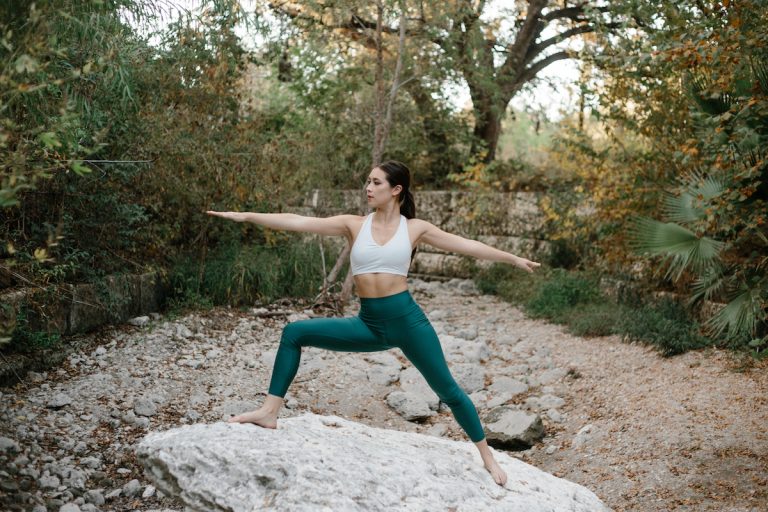
I have a love-hate relationship with sore muscles. After pushing through a difficult workout, I want to wake up the next morning feeling like I did something. But all too often, I find myself at the point where I can hardly move and am literally wincing with any and every small movement. And then…I tend to use my soreness as an excuse not to work out for the rest of the week, which (clearly!) isn’t helping me get into a routine. My Google search history is filled with phrases like “how to treat sore muscles” and “why am I so sore.” But responses like “stretch” and “pop some Advil”? Far from helpful.
So, on a personal mission, I reached out to Dustin Isom, a Certified barre3 Instructor and Certified Spin Instructor, to learn not only how to treat sore muscles, but also what causes them, so they stop getting in the way of my fitness goals. Consider this your complete guide to becoming an expert at how to treat sore muscles once and for all, including what causes them in the first place, and what to do before, during, and after a workout. Sore no more!
Featured image by Riley Blanks Reed.
What causes sore muscles?
In Isom’s words, “without getting too science-y with it,” physical exercise is essentially breaking down your muscle fibers, causing tiny microscopic tears. The soreness comes from that stress, which typically happens when you try a new type of exercise or if you increase the intensity. But, soreness is your body putting in extra work. The feeling comes from your body rebuilding the muscle fibers, and making them stronger than they were before. Hence, after consistent training, that soreness fades, as your muscles are more resilient and become “used to” the stress.
However, it’s important to note that “if you do not feel sore after a workout, that doesn’t mean you didn’t work hard enough.” Isom encourages that “if you’re on a set program, and you’re meant to stay consistent for a few weeks, the lack of soreness just means your muscles have gotten stronger and can handle the load.” So, one solution for how to treat sore muscles is to get yourself into a routine. I’m taking that as a personal sign.
What can I do before working out to prevent sore muscles?
If you’re like me, a warm-up is something I never seem to have time for. However, Isom points out that the best thing you can do for yourself before working out is warm up. “Warming up the body allows proper blood flow by revving up your cardiovascular system, which will send out oxygenated blood to the targeted muscles,” says Isom. Because these muscles can be targeted, it’s best to warm up with dynamic movements that mirror the exercises in your workout. For example, Isom explains that “if you’re doing squat presses in your workout, it would be best to warm up with some air squats.” Skipping the warm-up step can cause a different type of soreness “that results from muscle strain, tension, or even minor injury.” Aside from warming up your body, foam rolling, hydration, and rest are also beneficial pre-workout practices.
Is there anything I can be mindful of during a workout to protect my muscles from getting too sore?
Basically, safety comes first. Isom emphasizes the importance of exercising with proper form, because otherwise, soreness can come about from muscle strain or injury. He suggests always taking advantage of your resources–whether that be a wandering trainer at your gym or the instructor of your favorite fitness class. The key to success is “being mindful of how your body is moving” and taking note of “what does and does not feel good” or right, according to Isom.
5 Tips for How to Treat Sore Muscles, According to an Expert
Below are Isom’s top suggestions for how to treat sore muscles after a workout.
- Foam roll. Foam rolling is a super easy step that’s essentially like giving yourself a massage. It is a myofascial release, which is a fancy word for releasing the tension that builds in the body’s fascia. Fascia is the thin layer of connective tissue that wraps around your muscles, and foam rolling stimulates the circulation of blood, in turn, promoting mobility. If you’ve ever experienced that post-workout stiffness, the foam roller will be your best friend.
- Hydrate. Ensuring that you are properly hydrated is another important trick to treating sore muscles. Muscles need hydration because it flushes toxins out of the body, transports nutrients into the cells and helps regulate the body’s internal temperature. This will not only help with muscle soreness and tension, but overall post-workout recovery.
- Get adequate sleep. Sleep is super important because it’s the number one chance your body gets to fully recover from everyday activities. By not giving your body adequate sleep, you don’t give yourself the time it needs to fully recover and repair those tiny microscopic tears after training.
- Take an epsom salt bath. Epsom salt soaks are great for supporting your muscles and boosting exercise performance, as epsom salt contains high levels of magnesium. Magnesium is one of most abundant minerals in your body and has many inflammatory benefits. Plus, a hot bath will always feel amazing. Isom creates a concoction with epsom salt, bentonite clay, and apple cider vinegar and soaks for 20 minutes or until the water begins to cool. This can help relieve a lot of soreness, but also to detoxify the body. Check out our guide to the ultimate detox bath for more relaxing and restorative info.
- Maintain daily vitamin intake. Isom also takes vitamins daily that support muscle health, specifically magnesium, zinc and omega 3’s. Magnesium is good for muscle support and energy production, the fatty acids in omega 3’s reduce muscle soreness, and zinc helps with muscle repair post-workout. Definitely consult a dietitian or your doctor before starting anyvitamin and mineral routine.